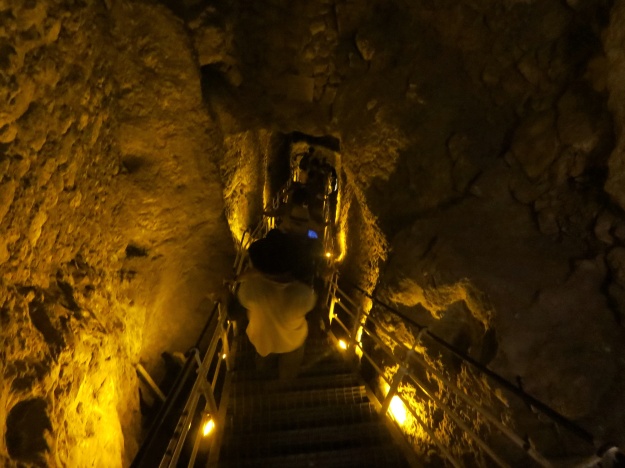Yesterday I was above Jerusalem, enjoying the panorama of the Old City from its fortified walls and ramparts. Today I was under Jerusalem, exploring some of the tunnels that go under the city!
As part of Ecce Homo’s Biblical Formation Programme, a guide led us on an exploration of the origins of Jerusalem, including the original Canaan settlement, the water supply, the arrival of Abraham from the Fertile Crescent, the City of King David, the first and second Temple, especially the renovation of the latter under King Herod the Great, followed by its destruction under the Romans, Byzantine rule, Muslim rule (various empires), British Mandate and the establishment of the State of Israel in 1948. The particular focus was what the archaeological evidence tells us in relation to the narratives of the different traditions, Judaism, Christianity and Islam.
We began with an introduction to the Western Wall, which is the the remaining support wall built under the rule of King Herod the Great for the vast platform on which the Temple stood (for details see: http://en.wikipedia.org/wiki/Western_Wall).
The usual place where men and women pray in segregated areas at the Western Wall is the exposed wall in front of the plaza (as seen in many photos, including an earlier post in this blog). However, the Western Wall is much more than that quite small exposed area. It extends north of that exposed area for a long distance and also for a shorter distance south of that particular area. The northern end of the Western Wall is largely concealed by the residential buildings of the Muslim quarter. These were built on a raised platform to provide ready access to the al-Aqsa Mosque on the Temple Mount for the five daily prayers. Accordingly, the foundations of this part of the Western Wall can only be accessed by “tunnels” that have been excavated. These “tunnels” are simply the emptied-out archways on which the raised Muslim quarter was built and were our first visit for the day.
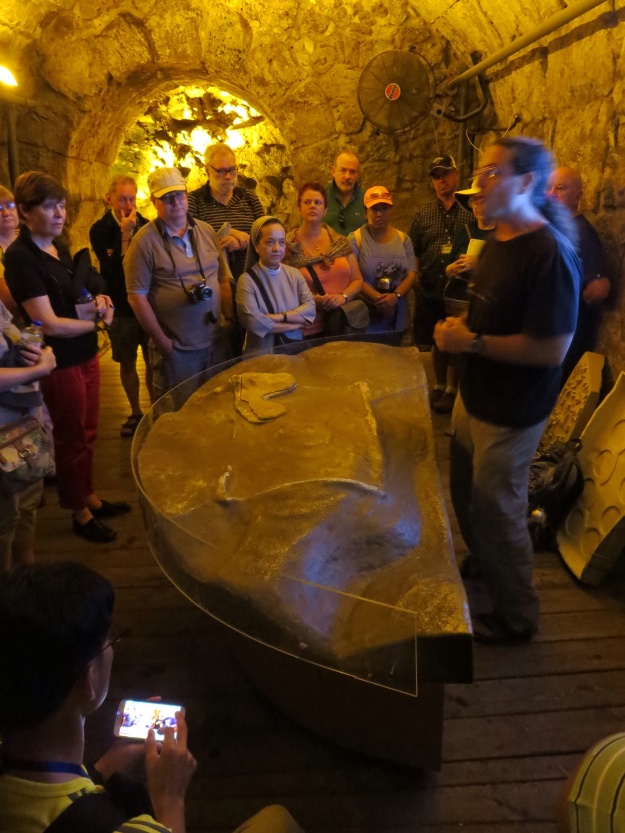
Here is our guide explaining to us the history of the site by using a model of the hill on which the Temple was built.
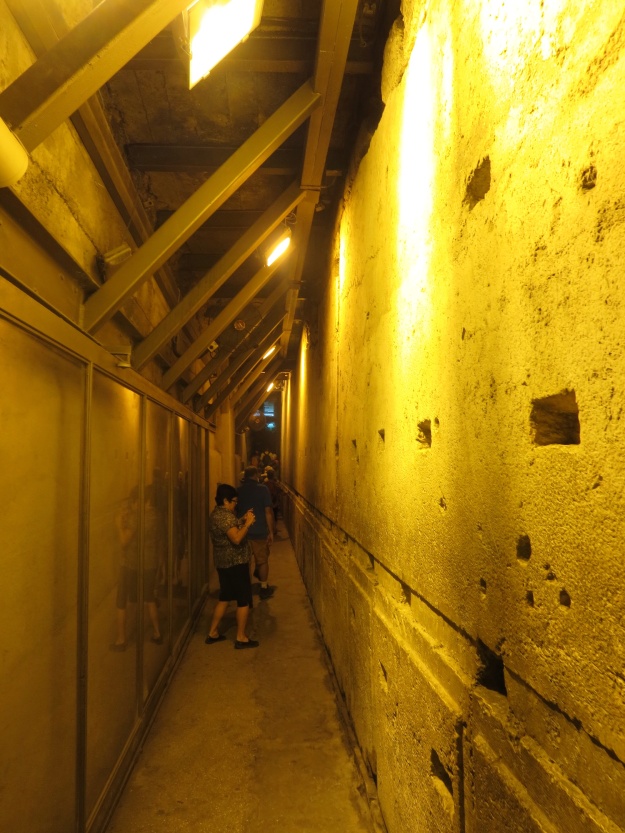
Here is a view along the excavated alleyway that runs along side the foundation walls of the Western Wall. The stones which form the wall are massive, some of them weighing tons, needed to support the weight of the platform above on which the Temple and other buildings stood.

In that area along the Western Wall calculated to be nearest to/aligned with the place where the Holy of Holies of the Temple once stood, there is a small prayer room for women on one level and above it a synagogue for men. An electric candle flickers in a niche in the wall to highlight the proximity to that very sacred place.

Beyond the northern end of the Western Wall, the excavated passageway was once an aqueduct, supplying water to the Temple. After the destruction of the Temple by the Romans in 70AD, the Emperor Hadrian diverted the aqueducts and had cisterns built and covered over to supply his newly-established town. In fact, the Ecce Homo archways which are retained in the Ecce Homo Basilica, over the Via Dolorosa and in the Muslim institute on the other side of the road are the entrance archways to the market of that town, and beneath the buildings are the remnants of the cisterns.
After a coffee break at Ecce Homo, we then headed for the “City of David” on the southern end of Jerusalem, outside the walls of the city. Archaeological evidence indicates that the first Canaan settlement in the area was here, availing of the spring of water in the Kidron Valley below.

View from the shoulder of the hill looking down towards the Kidron Valley and the spring which supplied the earliest and subsequent settlements.
According to the Bible, as recounted in the book of Genesis, Abraham came to this land with his family and entourage. He had a son named Isaac, whom Abraham was called to offer in sacrifice. Having shown his fidelity, God intervened and the child was saved. Jewish (and Muslim) tradition hold that this event occurred on the mountain where the Temple in Jerusalem would later be erected. Isaac had a son named Jacob, later re-named Israel, the father of the twelve sons from whom come the 12 tribes of Israel. Then, according to the book of Exodus, when a later generation of Israelites were freed from slavery in Egypt under Moses, after wandering in the desert for 40 years, they conquered the land and settled here. However, as the books of Judges and Kings shows, the people wanted to be like other peoples, with a king ruling over them, so Saul was anointed King, followed by David. Hence, the narrative highlights David, coming from Bethlehem (remember the Nativity story, Joseph being of the House of David), as the King of Israel. David’s son, Solomon, built the Temple on the hill above the city, which, over centuries, was to become the focus of Jewish identity and devotion, down to the present day.
The city also has a strong resonance for Christians, not only for the Old Testament accounts, but particularly as the place where events in Jesus’ life took place, especially his passion, death and resurrection. It also has strong resonance for Muslims, as the place of Prophet Muhammad’s mystical visit and ascent to heaven.
However, the archaeological evidence is much sparser than the above biblical narrative. Certainly, there was a Jewish settlement in that area; certainly, the settlement included a royal palace on the brow of the hill, which may or may not have been David’s; certainly there was a Jewish temple further up the hill, as a place of pilgrimage and worship. There is archaeological evidence of other people who in the biblical narrative are associated with David, so the proposition that this was in fact David’s city is quite possible. But in the end, this is where faith enters to affirm truths and meanings that are not accessible to empirical research.
The point was made that while the brow of the hill is ideal for defence – attackers have to advance uphill – the problem with a hilltop location is that it leaves the water supply in the valley below exposed and vulnerable to attack/siege. In this instance, a fortress was built around the spring, connected to the settlement on the hill by a wall. But this too was vulnerable. So an enterprising ruler had an underground tunnel built from the hill-top settlement to the spring in the valley below so that his people could access the water without fear of attack or ambush. We descended down this tunnel to the ancient spring below.
In a later era, King Hezekiah, facing an invasion from the Assyrians, feared that not even this tunnel would be able to protect the water supply from a prolonged siege. He conceived a novel idea. By that time, the settlement had expanded significantly, spreading over the hill to the west, Mount Zion. The walled fortifications of the expanded settlement now enclosed two hills, the Temple Mount and Mount Zion, and the valley in between the two hills. Rather than simply reinforce the defence of the water supply in the Kidron Valley, King Hezekiah relocated the the water supply. He had a tunnel dug all the way under the hill to the other valley which was safe within the fortified walls of the city and had the water diverted there (for details see .http://en.wikipedia.org/wiki/Hezekiah’s_Tunnel).
We walked through this ancient tunnel, for the first few metres, knee deep in flowing water, and for the rest of the distance, ankle deep in flowing water. It is 533 metres long and took about 40 minutes to walk through. It was quite narrow, just wide enough for a person to fit through. In places it was only about one and a half metres high, so I had to stoop low to get through. In other places, it was very high, four to five metres. As we were walking through it, I tried not to think that we were in an area subject to earthquakes!
On the other side of the mountain the water was collected in a pool, known in the New Testament as Siloam. Here is an excerpt from the Gospel of John 9:1-41 from the story of a miracle that Jesus performed at the Pool of Siloam:
A Man Born Blind Receives Sight
1 As he walked along, he saw a man blind from birth. 2 His disciples asked him, “Rabbi, who sinned, this man or his parents, that he was born blind?” 3 Jesus answered, “Neither this man nor his parents sinned; he was born blind so that God’s works might be revealed in him. 4 We must work the works of him who sent me while it is day; night is coming when no one can work. 5 As long as I am in the world, I am the light of the world.” 6 When he had said this, he spat on the ground and made mud with the saliva and spread the mud on the man’s eyes, 7 saying to him, “Go, wash in the pool of Siloam” (which means Sent). Then he went and washed and came back able to see. 8 The neighbors and those who had seen him before as a beggar began to ask, “Is this not the man who used to sit and beg?” 9 Some were saying, “It is he.” Others were saying, “No, but it is someone like him.” He kept saying, “I am the man.” 10 But they kept asking him, “Then how were your eyes opened?” 11 He answered, “The man called Jesus made mud, spread it on my eyes, and said to me, ‘Go to Siloam and wash.’ Then I went and washed and received my sight.” 12 They said to him, “Where is he?” He said, “I do not know.”

The (now dry) pool of Siloam. The steps leading into the pool are on the right-hand side of the photo. Under the awning is a tank into which the water flowing through the tunnel feeds. The tunnel comes over 500 metres, all the way under the hill in the background.
For the final part of our expedition, we took a bus up the hill and entered into the Old City through the Dung Gate!
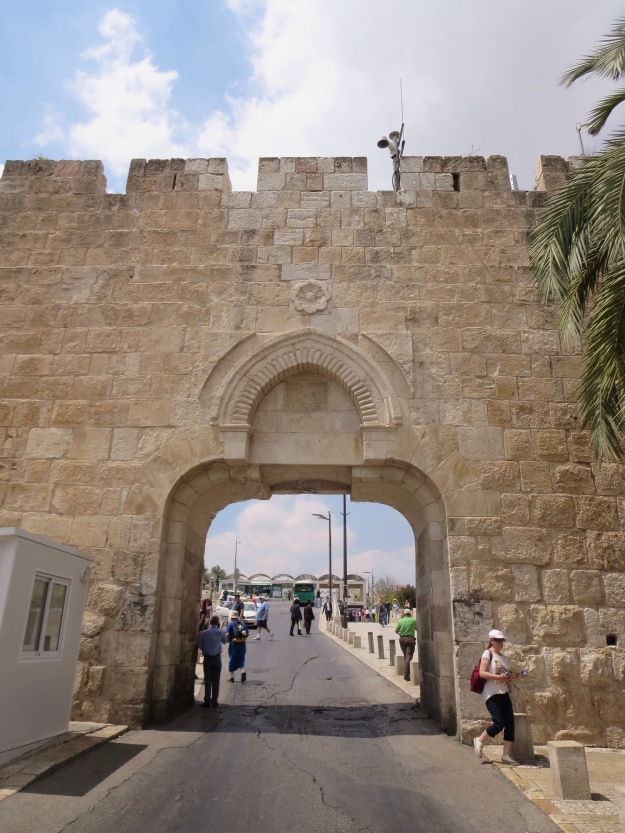
The Dung Gate – not a particularly auspicious name, but so named because in ancient days this was where the sewerage and rubbish flowed out from the city. It can be assumed that the huge number of animal sacrifices being carried out in the Temple also generated a lot of waste, offal and so on, which would also have had to be disposed of, and presumably it too made its way out through this area.
The day’s expedition had started at the Western Wall; and we finished at the Western Wall. But now we had a new and enriched perspective on it. The original settlement started from the spring of water in the Kidron Valley below; in King David’s time Jerusalem had grown to a town with a walled fortress on the brow of the hill which included the royal palace; his son, Solomon, had the Temple built on the summit of the hill overlooking the royal palace; over succeeding generations, with the ups and downs of history, of conquests and re-building, Jerusalem had expanded and had grown into a city, the imposing Temple on the Temple Mount being the pre-eminent symbol of the city’s identity and allegiance to God.
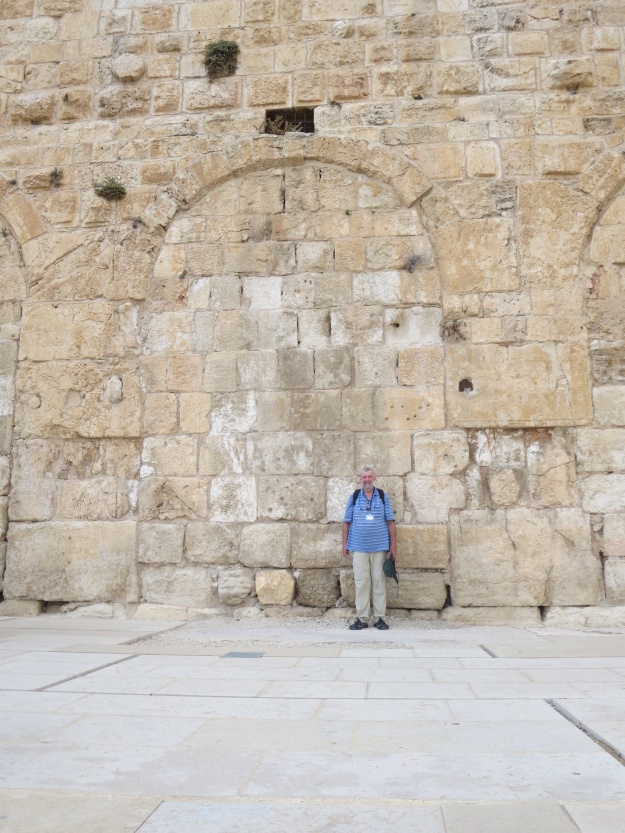
A view of the southern wall of the Temple platform. Pilgrims, having performed the required ablutions, approached from this direction. They entered through a triple doorway, paid their Temple Tax, presented their offering to the priests to be sacrificed, and exited through a double doorway. The contemporary pilgrim is standing in the central archway of the triple doorway point of entry.
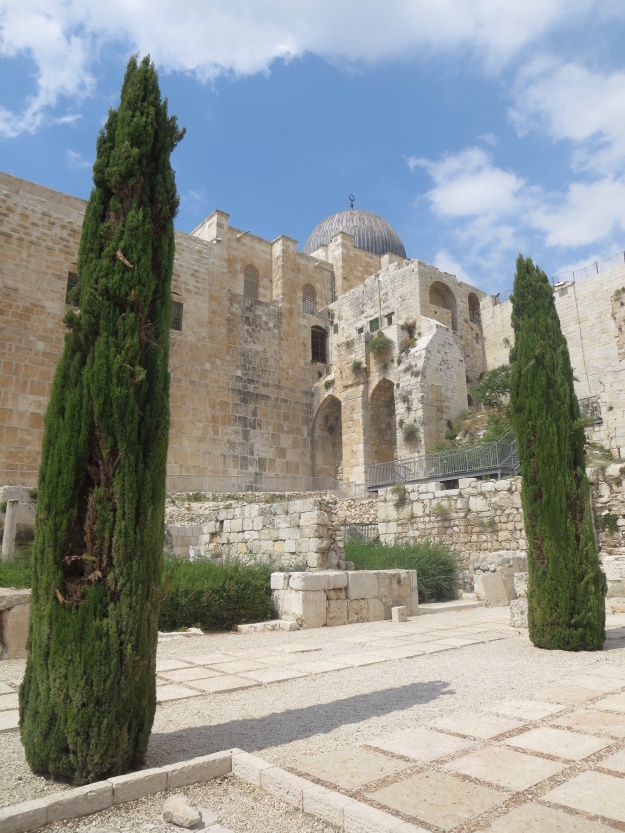
Another view of the southern wall. After the Muslim conquest, the al-Aqsa Mosque and the Dome of the Rock were built on the platform on which the Temple had once stood. The dome of the mosque can be seen rising above the wall in the top centre of the photo.
The al-Aqsa Mosque is named after an event reported in the Qur’an in which the Prophet Muhammad was said to have been transported by night from the “sacred mosque” (= Mecca) to “al-masjid al-aqsa” (translation “the further mosque”, said to be in Jerusalem, hence the name of the mosque). The accounts report that the Prophet Muhammad met other prophets there and led them in prayer. Hence, the mosque was established on that spot as a place of prayer for Muslims.
The Dome of the Rock, further to the north on the platform and not visible in this photo, marks another event which is said to have occurred during that night visit to Jerusalem, that the Prophet Muhammad ascended to heaven, meeting and passing other prophets along the way, including Jesus, Abraham and Moses, to the very presence of God. It is said that his footprint is in the rock from which he ascended, and the Dome of the Rock was built over that particular spot, marking it as a sacred site.
In later years an Ottoman Palace was built on the lower ground level from which the Muslims administered the city. It no longer exists, but it covered the area in the foreground from the southern wall of the Temple platform to the southern wall of the city.
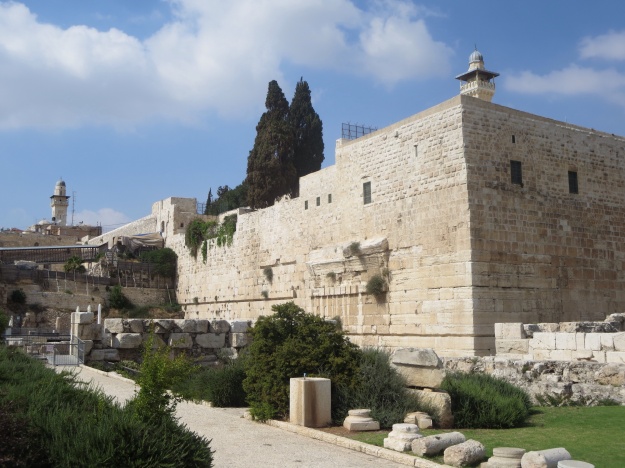
A view of the south-west corner of the Temple platform wall. The street running along the western wall was the Main Street of Jerusalem, with money changers and shops on either side, selling animals for sacrifice in the Temple as well as household goods. It was the place where people gathered in great numbers to buy and sell, to greet and meet, to pass the time of day.
It is here that in later years, with some discontent about the Hellenic culture overriding the ancient faith and customs of the Israelite ancestors, that the rabbis gathered to teach the people and to gather followers. It is likely that Jesus also may have addressed the crowds here.
It seems that the money changers and shopkeepers must have encroached onto the Temple platform itself, for the Gospels record that Jesus overturned the tables of the money changers and of those who were selling doves, sheep and cattle! cf. Mt 21:11-13, Mk 11:14-16, Jn 2:14-16.
To conclude the day’s excursion, which had begun and ended in the plaza in front of the Western Wall, I entered the prayer area, touched the Western Wall and prayed. For Christians, it was Pentecost Sunday. This particular day had added significance for it was also the day on which Pope Francis had invited Israeli President Shimon Peres and Palestinian leader Mahmud Abbas to the Vatican to pray for peace in the Middle East. Standing at the Western Wall, I joined them in spiritual solidarity and prayed for peace in the Middle East.
Shalom, Peace, Salaam.
